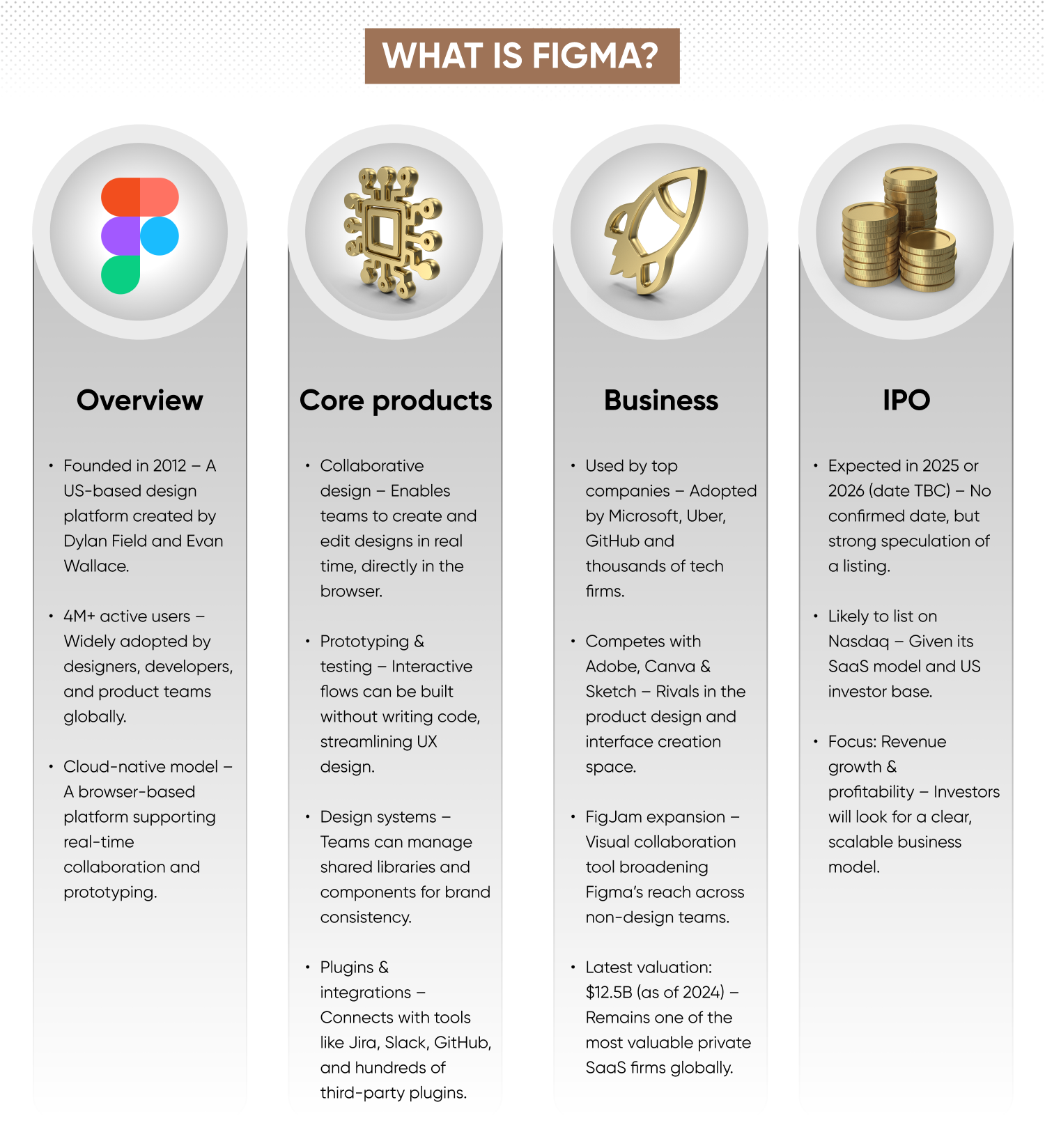Figma IPO – how to trade Figma shares

When was the Figma IPO date?
Figma officially made its initial public offering (IPO) on the New York Stock Exchange (NYSE) under the ticker ‘FIG’ on 31 July 2025. Shares were priced at $33 – above the top end of its expected range – raising around $1.2bn.
The design software company’s stock more than tripled on day one, closing at $115.50 and valuing the firm at nearly $68bn. That makes it one of the biggest tech IPOs in recent years, amid a rebound in public listings.
This marks a significant milestone after a $20bn acquisition deal with Adobe fell through in 2023 following regulatory concerns in the UK.
What is Figma?
Figma is a collaborative web-based design platform that enables teams to create user interfaces, wireframes, prototypes, and design systems – all in real time, from a browser.
Founded in 2012 by Dylan Field and Evan Wallace, Figma has become a key tool in digital product development, used by designers, developers and marketers at some of the world’s biggest tech companies.
Key milestones in Figma’s history
-
2012 – founded in San Francisco with a mission to bring design into the cloud.
-
2016 – official public launch, with core features around real-time design collaboration.
-
2018 – introduced design systems and plugin support, expanding into enterprise teams.
-
2020 – surge in usage as remote work boosted demand for cloud-based tools.
-
2022 – Adobe announced plans to acquire Figma for $20bn, but the deal was ultimately scrapped in 2023 following regulatory concerns.
-
2023 – reached over 4m active users; reported revenue approaching $600m annually.
-
2025 – lists on the NYSE, raising around $1.2bn.
Figma’s key features
-
Real-time collaboration – multiple users can design simultaneously, similar to Google Docs for design.
-
Cross-platform access – entirely browser-based, with optional desktop apps for macOS and Windows.
-
Prototyping tools – build interactive flows without needing to code.
-
Design systems – organise shared styles, assets and components for team consistency.
-
Plugins and integrations – connect Figma with tools like Slack, Jira, and GitHub.
-
Community hub – a library of free templates, UI kits, and widgets.
Figma also owns FigJam, a whiteboard tool for team brainstorming and mapping, introduced in 2021. It complements Figma’s core offering and helps expand its appeal beyond just designers.
Figma has become more than just a design tool – it’s a central hub for cross-functional product teams. Developers, product managers and marketers all use Figma to collaborate on user flows, gather feedback, and speed up handoffs between design and development. Its cloud-first approach has helped streamline the entire product lifecycle, from ideation to launch.

How does Figma make money?
Figma uses a freemium model, offering a generous free tier alongside paid plans for teams and enterprises. Its scalable pricing model makes it attractive to both solo designers and Fortune 500 companies.
|
Revenue stream |
Description |
|
Subscription plans |
Figma earns revenue primarily through monthly and annual subscriptions across individual, team, and enterprise tiers. Plans scale by feature set and usage needs. |
|
Enterprise contracts |
Large companies pay for advanced security, admin controls, and integrations – often on multi-year contracts. |
|
FigJam monetisation |
Originally offered free, FigJam is now monetised via team plans bundled with Figma. |
|
Partner ecosystem |
Figma’s growing network of plugin developers and integration partners creates long-term stickiness, with opportunities for revenue-sharing in future. |
|
Education & startup programmes |
While not currently revenue-generating, these initiatives build user loyalty early and support long-term conversion. |
This SaaS-based model allows Figma to maintain high gross margins, which may support strong investor interest when it lists.
Enterprise adoption is a major growth driver for Figma. Large organisations often roll out Figma across multiple departments, generating predictable, multi-year contract revenue. The platform’s collaborative features and centralised design systems are particularly valuable for globally distributed teams, helping to embed Figma deeply within an organisation’s tech stack.
What might influence the Figma live stock price?
Now that Figma is publicly traded, its stock price will likely be influenced by internal performance, broader market conditions, and sentiment toward SaaS and design tech. Here are some of the key factors that could shape its valuation.
Macroeconomic trends and SaaS sector sentiment
Figma’s performance may be closely tied to tech market conditions. In a high-rate environment, investor appetite for growth stocks typically softens. But as interest rates ease or stabilise, demand for software names – particularly those with strong fundamentals – often improves.
Broader sentiment toward SaaS will also matter. Following a quiet IPO window in 2022-2023, investor interest in cloud software has picked up. If this trend continues, it could create tailwinds for newly listed firms like Figma. However, any sector-wide pullbacks may also affect its share price.
Company fundamentals: revenue, growth, and margins
Investors will focus on Figma’s ability to sustain high revenue growth and healthy margins. SaaS-specific metrics such as annual recurring revenue (ARR), net dollar retention (NDR), and customer acquisition cost (CAC) will likely be used to assess performance.
Consistent growth and a clear path to profitability could drive positive momentum. But if revenue slows, or if user growth disappoints, the stock may face pressure – especially in the early quarters after listing.
Competitive threats and product innovation
Figma’s position as a category leader may be tested by competitors such as Adobe, Canva, and emerging open-source tools. The company’s ability to retain enterprise clients and innovate – for example, with AI design tools or enhanced developer workflows – will be key to maintaining its edge.
Slower feature rollout or market share loss could raise investor concerns. However, strong product development and new monetisation channels, such as paid plugins or expanded FigJam features, may support a more optimistic view.
Regulatory landscape and strategic clarity
While Figma itself isn’t a regulated business, its blocked acquisition by Adobe has placed it under the regulatory spotlight. Investors may keep a close eye on competition-related developments and data privacy rules that affect how software platforms scale.
That said, Figma’s independent path may also be seen as a strength – giving it freedom to grow without regulatory constraints tied to a larger corporate parent.
Media coverage, sentiment and early trading behaviour
In the days and weeks after listing, price movements were driven by market sentiment, news headlines and trading activity. From here, positive press, strong analyst coverage or bullish retail interest could lift the stock, while negative surprises may trigger volatility.
Earnings reports, product updates and any early guidance will be watched closely. As with other tech IPOs, initial performance could set the tone for how investors view Figma’s longer-term potential.
You can keep your finger on the pulse of the markets with expert insight from our in-house analysts. Check out our news and analysis section for more.

How to trade Figma shares via CFDs
Trading Figma's shares via contracts for difference (CFDs) allows you to speculate on its price movements – without owning the underlying stock.
How to get started
- 1. Choose a platformUse a trusted broker like Capital.com, offering access to thousands of shares, indices and more.
- 2. Open an accountProvide your personal details, verify your identity, complete a short suitability questionnaire, and set your trading preferences.
- 3. Add fundsDeposit using card or bank transfer. Start small, and manage your risk carefully.
- 4. Track Figma’s performanceUse our charts, technical indicators and price alerts to monitor the market and spot trading opportunities.
- 5. Go long or short with CFDsThink the price will rise? Go long. Expect a drop? Go short. Apply stop-loss or take-profit levels to manage your trades.
IPOs can be volatile, especially in the early days of trading. CFDs give you the flexibility to act on price swings in either direction. As always, it’s important to set clear risk-management parameters and stay informed with expert insights available through Capital.com’s platform and app.
Learn more about contracts for difference in our CFDs trading guide.
Which other SaaS and productivity tech stocks can I trade?
As an alternative to Figma, consider exploring these listed companies with similar business models or target markets:
-
Adobe (ADBE) – the digital media giant whose tools remain essential for creative professionals.
-
Atlassian (TEAM) – enterprise collaboration leader with products like Jira and Confluence.
-
Dropbox (DBX) – focused on cloud storage and team collaboration.
-
Asana (ASAN) – workflow management and productivity software.
-
Zoom (ZM) – popular video communication platform used by remote teams.
Capital.com also offers access to major tech indices, including the US Tech 100, giving you broad exposure to listed software and cloud leaders. Whether you’re trading individual names or entire sectors, you’ll find tools to support your strategy.
Learn more about shares and stock markets in our comprehensive shares trading guide.
FAQs
Who owns Figma?
Figma's founders, Dylan Field and Evan Wallace, maintain significant stakes, alongside venture capital firms including Sequoia Capital, Andreessen Horowitz, Greylock, Index Ventures and Kleiner Perkins.
How much is Figma worth?
Figma was valued at around $68 billion in July 2025 following its IPO. This marked an increase from its previous $12.5 billion valuation in May 2024. Its valuation from this point may change depending on market conditions, financial performance, and investor sentiment.
When did Figma IPO?
Figma made its IPO in July 2025, pricing shares at $33 – above the top end of its expected range – and raising around $1.2bn.
How can I buy Figma shares?
Following its July 2025 IPO, Figma shares became available to the public via direct ownership, as well as derivatives like CFDs.
Is Figma available to trade as a CFD?
When Figma went public, Capital.com made Figma CFDs available to trade. Leverage amplifies both profits and losses, making it risky.